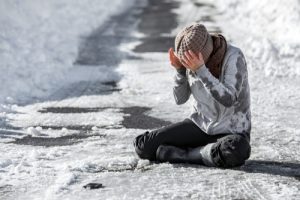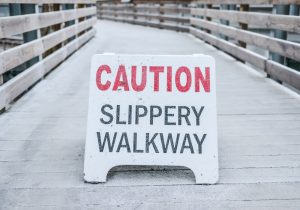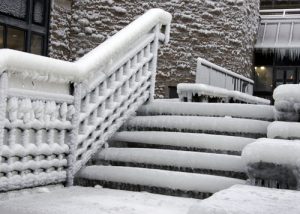 Injury and workers’ compensation cases involving slips and falls on snow and ice during winter in America’s northern states, and southern states this year, continue to be a perplexing subrogation puzzle for insurance claims and subrogation professionals. During the winter months, our office sees a flood of cases involving slips and falls on ice, snow, and slush during winter conditions. It is important to understand when and how liability attaches in such cases – and when it does not.
Injury and workers’ compensation cases involving slips and falls on snow and ice during winter in America’s northern states, and southern states this year, continue to be a perplexing subrogation puzzle for insurance claims and subrogation professionals. During the winter months, our office sees a flood of cases involving slips and falls on ice, snow, and slush during winter conditions. It is important to understand when and how liability attaches in such cases – and when it does not.
Life is such that accidents happen, and they do occasionally happen because the injured victim is careless and not paying attention. The key to success in these types of cases is knowing the difference between such instances and those in which the negligence of a third party is responsible for injury. Juries know that in the winter months, plaintiffs need to tread more slowly and with more caution. Contributory negligence on plaintiffs in slip and fall cases is traditionally very high and such cases are not usually very good cases without extenuating circumstances. The reason? We all have a responsibility to watch where we are walking and this is especially true in winter, when we are all on notice of the naturally-occurring dangers and slippery conditions over which we all must traverse. While the laws of each state are somewhat different, they almost all have certain basic principles in common. We will use Wisconsin as an illustration.
Wisconsin, like many states, creates a legal distinction between privately-owned property and public property. Private property owners owe a duty of reasonable care to invitees – persons invited, implicitly or explicitly, upon the real property of another. Public property owners, and maintenance companies, owe a much higher duty to people on their property, than do private property owners. Wisconsin, like other states, also creates a distinction between the classes of individuals who are injured. Private property owners owe a different duty to trespassers as opposed to non-trespassers. A trespasser is someone who goes on somebody’s private property without permission and without their knowledge.
Private Property. Wisconsin private property owners owe different duties to trespassers as opposed to non-trespassers. In Wisconsin, a trespasser is defined as someone who goes onto someone’s private property without consent or an invitation. If an individual is considered to be a trespasser, then the Wisconsin private property owner cannot willfully, wantonly, or recklessly inflict injury upon the trespasser. If the owner knew or should have known of the trespasser’s presence on the property, then the owner cannot do anything likely to cause injury to the trespasser. As you can see, the burden of proof here – essentially an intentional act – will be extremely hard to prove.
With regard to non-trespassers, a private property owner must only use ordinary care under the circumstances to construct, manage and maintain the premises to avoid exposing non-trespassers to an unreasonable risk of harm. Such private property owners have a duty to discover and make safe conditions on their property that would likely expose a non-trespasser to an unreasonable risk of harm. If an unreasonable risk of harm existed and the owner knew of it or should have known of it, then the owner has a duty to either fix the problem or warn of the condition.
 Public Property. Slips and falls on public – as opposed to private – property, present many different concerns. By “public property” we are referring to government property and property owned by businesses onto which the public is both invited and expected to traverse. The majority of Wisconsin injuries on public property involve a series of statutes known as Wisconsin’s Safe Place Law, which applies to public buildings and places of employment. This law requires certain public property owners and employers to keep their premises as safe as the nature of their business reasonably permits. This requirement includes the construction, maintenance, and repair of the premises. As with private property, trespassers are not covered by the Wisconsin Safe Place Law. Business and employers are not required to keep their property absolutely safe, but they are required to keep the property as free from danger to the life, health, safety, or welfare of visitors or employees as the nature of the property will reasonably permit. This requires the owner or employer to use reasonable care in inspecting the property for potential hazards and making safe any hazards which it can.
Public Property. Slips and falls on public – as opposed to private – property, present many different concerns. By “public property” we are referring to government property and property owned by businesses onto which the public is both invited and expected to traverse. The majority of Wisconsin injuries on public property involve a series of statutes known as Wisconsin’s Safe Place Law, which applies to public buildings and places of employment. This law requires certain public property owners and employers to keep their premises as safe as the nature of their business reasonably permits. This requirement includes the construction, maintenance, and repair of the premises. As with private property, trespassers are not covered by the Wisconsin Safe Place Law. Business and employers are not required to keep their property absolutely safe, but they are required to keep the property as free from danger to the life, health, safety, or welfare of visitors or employees as the nature of the property will reasonably permit. This requires the owner or employer to use reasonable care in inspecting the property for potential hazards and making safe any hazards which it can.
Wisconsin Safe Place violations by building owners can be separated into two types: structural defects and defects associated with the structure. A structural defect is an unsafe condition on property that has been “built-in” in the sense that structural defects include improper building materials, improperly designed buildings, or even an improperly laid out building. Steps that do not have appropriate traction or the lack of a handrail on a stairway where one is required would be examples of structural defects. A defect associated with the structure means an unsafe condition due to disrepair or lack of adequate maintenance. The main distinction between structural defects and defects associated with the structure is that injured persons are not required to prove that the owner of the property was aware, or should have been aware, of the structural defect.
Wisconsin injury victims can also pursue claims against public property owners in Wisconsin under a general negligence theory. As with all negligence claims, the plaintiff is required to show the following:
- Duty. The owner had a general duty to keep their premises safe.
- Breach. The owner breached their duty to keep their premises safe.
- Proximate Cause. The plaintiff was injured due to the owner’s breach of their duty.
- Damages. The plaintiff was injured due to the owner’s breach of their duty.
The two most difficult aspects of any premises liability case are (1) establishing the breach of a duty – evidence that the owner of the premises knew of a defect and failed to take any action to correct it, and (2) overcoming the open and obvious defense – the natural tendency of many jurors to conclude that the instrumentality on which the plaintiff slipped and fell would and should have been open and obvious to an alert person, increasing the likelihood of placing 50% or more contributory negligence on the injured plaintiff, which in many states will eliminate any recovery.
The difficulty of prevailing in slip and fall cases involving snow and ice becomes evident when you consider the above-referenced two difficult areas. When nature dumps snow and ice on property, the law alters the responsibility of the landowner because such natural accumulations of snow and ice affect us all and we are all on notice of them. Some municipalities require property owners to clear the sidewalks in front of their homes and buildings (New York), and owners of stores and offices are required to clear the entrances and exits to their buildings. Slips and falls in public places such as this are more likely to result in a recovery than a similar fall in front of somebody’s home. Parking lot owners, if they intend for their parking lot to be used, need to clear the snow and ice from their parking lots.
 Reasonableness in the law dictates that a landowner does not need to clear walkways in the middle of a snowstorm, but should do so in a reasonable time after a storm. Private homeowners have more leeway. To determine liability for slips and falls on snow and ice, states like Illinois follow what is known as the Natural Accumulation Rule. In order for there to be liability for a fall on snow or ice, the snow or ice must be an unnatural accumulation of snow or ice. If it is a natural accumulation of snow or ice, there is generally no liability. The dividing line between a natural and unnatural accumulation of snow and ice is not always very clear. Generally, the snow and ice is considered a natural accumulation if it is the result of natural weather conditions. If the snow and/or ice was not shoveled or salted, there is less likely to be liability for the property owner. Going a step further, the law still considers ice which has been formed by snow being tamped down by pedestrian or vehicular traffic to be a natural accumulation of snow and ice. It also considers puddles of water inside of buildings resulting from pedestrians tracking in snow that melted to be a natural accumulation of snow. Whether accumulation of snow or ice on a public sidewalk is artificial or natural is a question of law. Exceptions to these rules exist where there is a provision in a lease for property where the management company or landlord agrees to remove snow and ice.
Reasonableness in the law dictates that a landowner does not need to clear walkways in the middle of a snowstorm, but should do so in a reasonable time after a storm. Private homeowners have more leeway. To determine liability for slips and falls on snow and ice, states like Illinois follow what is known as the Natural Accumulation Rule. In order for there to be liability for a fall on snow or ice, the snow or ice must be an unnatural accumulation of snow or ice. If it is a natural accumulation of snow or ice, there is generally no liability. The dividing line between a natural and unnatural accumulation of snow and ice is not always very clear. Generally, the snow and ice is considered a natural accumulation if it is the result of natural weather conditions. If the snow and/or ice was not shoveled or salted, there is less likely to be liability for the property owner. Going a step further, the law still considers ice which has been formed by snow being tamped down by pedestrian or vehicular traffic to be a natural accumulation of snow and ice. It also considers puddles of water inside of buildings resulting from pedestrians tracking in snow that melted to be a natural accumulation of snow. Whether accumulation of snow or ice on a public sidewalk is artificial or natural is a question of law. Exceptions to these rules exist where there is a provision in a lease for property where the management company or landlord agrees to remove snow and ice.
Prompt and thorough investigation of slip and fall cases are necessary for claims and subrogation professionals. They must look for and memorialize features or defects in the property which causes snow or ice to accumulate in a particular location or in a particular manner. A common example of this would be a down spout which dumps water onto a sidewalk where it freezes and becomes ice. Also, look for evidence of actions on the part of the property owner which cause snow or ice to accumulate in a particular location. This might include an owner piling snow in a dangerous location. Cases involving falls on snow or ice require a thorough analysis of the facts before it can be determined whether there is liability for falls on snow or ice, and this investigation must come immediately after notice of such an injury – preferably the same day notice is received.
Slips and falls involving a fall on snow or ice are usually not worth pursuing unless there are significant injuries such as herniated discs, fractures or other injuries which require surgery. This is because of the research and investigation which is required in order to make such cases fly. Liability carriers almost always take the position that there is no liability for a fall on snow or ice and that suit will almost always have to be filed and a hard-fought fight is almost a certainty. Therefore, a subrogated carrier must be willing to invest the time and money necessary to prove the elements needed for liability to attach. Don’t rely on subrogation counsel to investigate every small slip and fall case for you. Make a decision on a case by case basis – using the facts of the individual cases to discriminate between good cases and bad cases. Take lengthy statements of the victims, the property owners, and any witnesses. Take photographs and measurements of the conditions which existed at the time of the fall. Unfortunately, there are no shortcuts when it comes to subrogating slips and falls on snow and ice.
If you should have any questions regarding this article or subrogation in general, please contact Gary Wickert at gwickert@mwl-law.com.






